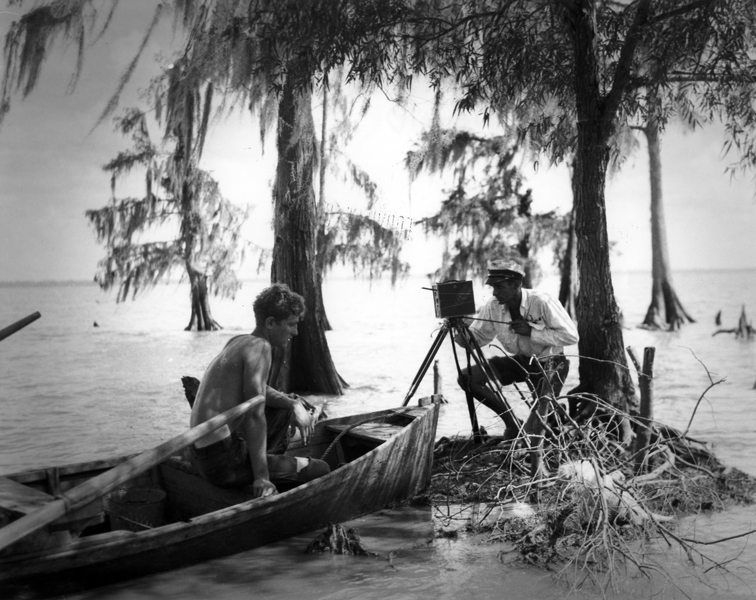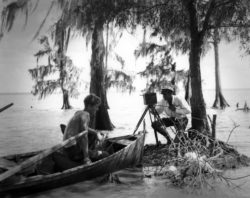Photography
Native-born and out-of-state photographers alike have been drawn to Louisiana's swamps and bayous, its historic architecture, its Cajun and Creole cultural traditions, and its diverse and complex society.

Courtesy of State Library of Louisiana.
B&W photo, 1930s. Fonville Winans (behind camera) filming a man in a boat on south shore of Lake Palourde, St. Mary Parish. Head of Bayou Ramos.
From the earliest days of the medium, photographers have focused their cameras on the life and landscapes of Louisiana.Native-born and out-of-state photographers alike have been drawn to the state’s swamps and bayous, its historic architecture, its Cajun and Creole cultural traditions, and its diverse and complex society. The photos these artists produce reflect not only the state’s unique culture but also broader trends in American photography.
Photography in Early Louisiana
Photography came to Louisiana only a few months after the announcement of its birth in 1839. In 1840, Jules Lion, a free man of color, exhibited daguerreotypes of St. Louis Cathedral and other New Orleans scenes. Born in France, Lion immigrated to New Orleans in 1836 or early 1837. During one of his trips back to France, he learned about the daguerreotype, the forerunner of photography, from its inventor, Louis Jacques Mandé Daguerre. With Lion’s introduction, New Orleans became the second US city (the other was New York City) to adapt the revolutionary technology.
From 1858 until the beginning of the Civil War, Jay Dearborn Edwards documented buildings in New Orleans and the riverfront wharves. Edwards worked as a photographer during the war, as did Andrew D. Lytle of Baton Rouge. Lytle also photographed the lumber industry and prisoners at the Angola, the Louisiana State Penitentiary. After immigrating from France in 1873, Mother Ste. Croix lived in the Ursuline Convent in New Orleans where she began photographing the convent buildings and grounds. She also made skillful portraits of students and teachers there. In 1884, George Francois Mugnier opened a studio in New Orleans. In addition to studio portraiture, his subjects included cityscapes, bayous, cane fields, and plantations.
Pictorialists
Like their counterparts elsewhere, Louisiana photographers experimented with pictorialism, a photographic style that seeks to emulate paintings, in the late nineteenth and early twentieth centuries. Using soft focus, special filters, lens coatings, and special developing techniques, pictorialists attempted to soften their photographs and romanticize or idealize their subject. In his 1926 book Impressions of Old New Orleans, for example, Arnold Genthe used a soft-focus to create nostalgic, idealized images of the French Quarter and Garden District.
Working in a similar pictorial style, New York photographer Doris Ulmann photographed traditional craftspeople in New Orleans, as well as workers at Melrose Plantation in the Cane River region in 1931. New Orleans photographers Joseph Woodson “Pops” Whitesell and Eugene A. Delcroix were also part of the pictorial tradition. Whitesell is best known for luminous cityscapes and portraits, including those of writers Sherwood Anderson, Sinclair Lewis, and Lyle Saxon. In 1938, Delcroix published Patios, Stairways and Lace-Iron Balconies of Old New Orleans.
Documentary Photography and Social Reform
Another group of photographers, both inside and outside Louisiana, wanted to use photography to help bring about social reform. As part of his work for the National Child Labor Committee, documentary photographer Lewis Hine came to Louisiana in 1911, seeking evidence that would support the campaign to abolish child labor. In sharply focused black-and-white pictures, Hine showed children working in oyster and shrimp plants.
In 1935, the federal government hired photographers to generate support for its New Deal programs. From 1935 to 1942, photographers working for the Resettlement Administration (renamed the Farm Security Administration in 1937) traveled throughout the United States, documenting the suffering caused by the Great Depression. Toward this end, photographers Walker Evans, Dorothea Lange, Russell Lee, Carl Mydans, Arthur Rothstein, Ben Shahn, and Marion Post Wolcott, among others, photographed Louisiana in the 1930s. Some of these photographs were included in Gumbo Ya Ya: Folk Tales of Louisiana (1945), a book written by Robert Tallant and Lyle Saxon from material gathered by the Federal Writers’ Project of the Work Projects Administration.
Louisiana was also included in the Standard Oil survey, a photo documentary project initiated in 1943 in the hopes of bolstering the corporation’s image. As a major oil-producing state, Louisiana was well-represented in the public relations effort. Photographs by John Collier, Russell Lee, Sol Libsohn, John Vachon, Todd Webb, and others depicted oil fields and refineries, offshore drilling, field workers, shrimpers, swamp lumbering, and other subjects, some only marginally related to petroleum.
Finally, in 1955, Swiss-born photographer Robert Frank received a Guggenheim Foundation grant to travel the United States and photograph what he saw. Three photographs from Louisiana appeared in his landmark 1959 study, The Americans. Like the photographs from other parts of America, Frank’s images of Louisiana capture racial and economic injustices. One of the photos depicts a segregated streetcar in New Orleans, the occupants rigidly divided by the vertical lines of the streetcar windows.
Architectural Photography
While the need for social reform drew many documentary photographers to Louisiana, a host of other subjects have captured the interest of photographers. The state’s unique architectural heritage, for example, drew photographers like Frances Benjamin Johnston, Clarence John Laughlin, and Edward Weston, among others. Johnson, a noted photojournalist and portraitist in Washington, D.C., traveled to Louisiana after receiving a grant from the Carnegie Corporation in 1933. As part of her efforts to photograph Southern architecture, Johnston visited historic structures in Louisiana and eventually bought a house on Bourbon Street, where she lived until her death in 1952.
Clarence John Laughlin, one of Louisiana’s most celebrated photographers, created more than 17,000 large-format photographs of plantations, New Orleans buildings, cemeteries, still lifes, and street scenes. His work, concerned mainly with the ravages of time and modernism, has been described as romantic, surrealistic, and symbolic. When California-based photographer Edward Weston visited Louisiana in 1941, Laughlin introduced him to New Orleans and nearby plantations. Weston went on to photograph St. Roch and other cemeteries, as well as in Lake Charles and Morgan City. In more recent years, New Orleans native Sandra Russell Clark published Elysium, A Gathering of Souls, a collection of photographs depicting New Orleans’ historic graveyards in a soft-focus, dreamlike style.
Portrait Photography
Other photographers were drawn to the unique people of Louisiana. Ernest J. Bellocq photographed the prostitutes of Storyville, New Orleans’s legalized red-light district in or around 1912. Bellocq received international recognition after his death, when eighty-nine negatives from his portraits were discovered. The photographs were exhibited at the Museum of Modern Art and published in Storyville Portraits in 1971. Bellocq’s life and work eventually became the basis of a major motion picture, Pretty Baby, in 1978. Among the best-known contemporary Louisiana portrait photographers is New Orleans painter and photographer George Dureau, who includes male nudes, dwarfs and amputees among his subjects.
Mardi Gras Photography
Among the most photogenic of topics, Mardi Gras has consistently lured photographers to Louisiana in general and New Orleans in particular. Among the most noteworthy are John Gutmann, a German-born photographer who attended Mardi Gras in 1937, and captured odd, exotic, and sometimes surreal moments and people. Charles L. Franck, a commercial New Orleans photographer, produced numerous images of Carnival between 1907 and 1955, generally presenting the festivities in a clean, straightforward style. In the late twentieth century, New Orleanian Syndey Byrd presented large colorful images of parades, balls, and musicians. While her work focuses on New Orleans and southern Louisiana, she has photographedcelebrations around the world.
Music Photography
Musicians are another frequently photographed aspect of Louisiana culture. Painter/photographer Ralston Crawford began photographing jazz musicians in New Orleans in the 1950s. Lee Friedlander’s photographs of New Orleans musicians were published in The Jazz People of New Orleans in 1992. In more recent years, New Orleans photographer Michael P. Smith documented the New Orleans Jazz & Heritage Festival, making thousands of images of musicians and parades. Mardi Gras Indians and neighborhood celebrations were among his favorite topics. Husband-and-wife team Keith Calhoun and Chandra McCormick document street music and street life in New Orleans, paying particular attention to the Lower Ninth Ward community.
Music can be heard, of course, outside New Orleans, and the New Orleans-based photographer Rick Olivier has photographed Cajun music and culture. His 1999 book Zydeco! features musicians and dance halls in southwestern Louisiana. Philip Gould’s photographs of Cajun musicians were published in Cajun Music and Zydeco published in 1992. He has also photographed riders, revelers, and chicken chasers celebrating Cajun Mardi Gras.
Photographing Rural Louisiana
Louisiana is, of course, more than New Orleans, and photographers have also captured images from more rural parts of the state. A.L. Bush, for instance, recorded the early-twentieth-century lumber industry in southeastern Louisiana. In the late 1940s, Elemore Morgan, Sr., a Baton Rouge native, traveled throughout the state making pictures for All This Is Louisiana, written by Frances Parkinson Keyes. He also worked for the state forestry association and as a commercial photographer in Baton Rouge. Many of his photographs present the everyday lives of rural people, vernacular architecture, and folk traditions. His son, Elemore Morgan, Jr., is best known for his paintings and color photographs of southern Louisiana landscapes and Cajun life.
Fonville Winans also documented the landscape and people of southern Louisiana, including Grand Isle. Debbie Fleming Caffery’s first book, Carry Me Home, published in 1990, featured dark and evocative photographs of sugar cane workers and residents of St. Mary Parish. Among the best-known contemporary nature photographers in the state are C.C. Lockwood and Julia Sims. Lockwood has photographed extensively in the Atchafalaya Basin and along the Gulf Coast. Sims is known primarily for her photographs of birds and the Manchac Swamp.
Conclusion
Most recently, Hurricane Katrina, which struck the Gulf Coast in August 2005, has drawn photographers to the state. In some sense, the storm resulted in a return to documentary photography, as thousands of photographers—professional and amateur, residents and outsiders—struggled to capture the sheer magnitude of the destruction the storm caused. Some of the most important Katrina pictures were made by staff photographers of The Times-Picayune, which earned a Pulitzer Prize for its reporting during and after the storm. Storm survivors and rescuers, of course, shot their own photographs, and often shared them with world via the Internet. Artists, including photographers, still struggle to make sense of the catastrophe and will likely do so for years to come.
